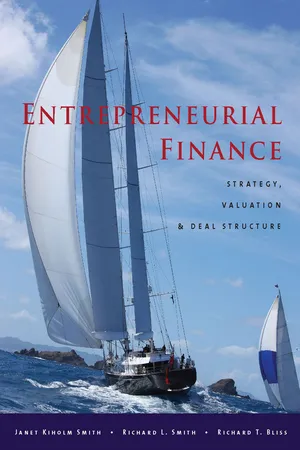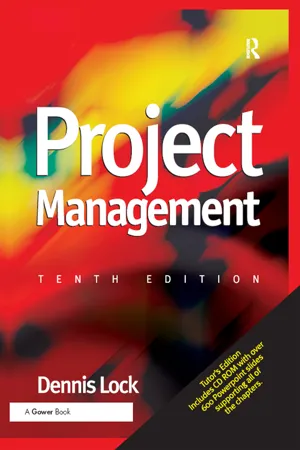Business
Project Valuation
Project valuation is the process of determining the financial worth of a specific business project. It involves assessing the potential returns and risks associated with the project to make informed investment decisions. By using various valuation methods such as discounted cash flow analysis or comparable company analysis, businesses can gauge the viability and profitability of their projects.
Written by Perlego with AI-assistance
Related key terms
Related key terms
1 of 4
Related key terms
1 of 3
7 Key excerpts on "Project Valuation"
- eBook - ePub
Project Valuation Using Real Options
A Practitioner's Guide
- Prasad S. Kodukula Kodukula, Chandra Papudesu(Authors)
- 2006(Publication Date)
- J. Ross Publishing(Publisher)
Most projects involve contingent decisions, where senior management can change the course of the project by deciding whether to defer the investment for a while; abandon, expand, or contract the project; maintain the status quo; and so on. There is great strategic value imbedded in these decisions, which can be taken advantage of only if management recognizes it and is willing to exercise the decisions. To capture the true value of a project in its assessment phase, the value of such decisions must be quantified and captured. Otherwise, a project of great future strategic value may be rejected because it cannot compete with other projects in a portfolio based on its short-term value only.There are three traditional tools that incorporate some or all of the above three factors into their Project Valuation calculations:Irrespective of the tool, the building blocks for the calculations are provided by present values of the cash flow streams.Discounted cash flow analysisMonte Carlo simulationDecision treesPRESENT VALUE
The methods that the financial analysts use to value projects may range from the simple to the sophisticated, but the building blocks for these methods are the same. Any valuation starts with estimation of development and production phase costs and net revenues (free cash flows) over the project life. Because of the time value of money, each cash flow from the future is converted into today’s dollars, using the formulawhere FV = future value, PV = present value, r = discount rate per time period, and n = number of the time period.For the sake of convenience, 1/(1 + r )n is typically calculated as “discount factor” for a given discount rate and time period and is multiplied by the FV to arrive at the corresponding PV.For example, for an annual discount rate of 10% and a two-year time period, the discount factor is 0.826 [i.e., 1/(1.10)2 ]. If the annual net cash flow on a project is expected to be $1 million two years from now, using six decimal places for the discount factor, the PV will be $826,446 ($1,000,000 * 0.826446). Equation 2-1 - eBook - ePub
Entrepreneurial Finance
Strategy, Valuation, and Deal Structure
- Janet Kiholm Smith, Richard L. Smith, Richard T. Bliss(Authors)
- 2011(Publication Date)
- Stanford Economics and Finance(Publisher)
The entrepreneur might expect that competition among prospective investors can eliminate the need to value complex financial claims. This expectation is incorrect. Even if several investors are vying to participate in a venture, they may have varying views of the venture’s strategy and will probably seek different structures of ownership claims and financing commitments. Without studying the valuation consequences of different proposals, choosing the best alternative can be problematic for the entrepreneur. A solid understanding of basic valuation techniques can ensure that entrepreneurs better understand how investors perceive the opportunity at hand and help both sides reach a mutually beneficial agreement.9.3 An Overview of Valuation MethodsFor an investor who cares only about financial return, the value of any investment is the PV of its future cash flows. Although a variety of methods exist for estimating value, ranging from explicit discounting of future cash flows to valuation based on simple multiples to valuation based on comparable firms, they all are attempting to measure, either directly or indirectly, the PV of the right to receive future cash flows.As discussed in Chapter 1, valuation is guided by two fundamental principles: that a dollar today is worth more than a dollar received in the future; and that a safe dollar is worth more than a risky one, that is, a safe dollar is more valuable than a gamble with an expected payoff of one dollar. Thus, the PV of any investment depends on the timing and riskiness of expected future cash flows.In theory, if a person could correctly identify expected cash flows, risk, and cost of capital, the result of a discounted cash flow analysis would be the “true” PV. In practice, however, there is considerable judgment involved in valuation. Because we must rely on estimates, we can be sure our calculations yield only approximations of true PV. Rather than despair, we should recognize that imperfect PV estimates provide opportunity. There are potentially large rewards for doing a better job than your rivals of estimating PV. Other things being equal, the entrepreneur or investor who consistently does a good job of estimating value will outperform the one who is right on average but makes large over- and underestimation errors. - eBook - ePub
Security Analysis and Business Valuation on Wall Street
A Comprehensive Guide to Today's Valuation Methods
- Jeffrey C. Hooke(Author)
- 2010(Publication Date)
- Wiley(Publisher)
2. Macroeconomic Review 3. Relevant Stock Market Prospects 4. Review of the Company and Its Business 5. Financial Analysis 6. Financial Projections7. Application of Valuation Methodologies8. RecommendationRecall the five broad approaches to business valuation (reiterated in Exhibit 12.1 ). Of these, only the first four lend themselves to the quasi-scientific method outlined in this book. They forecast stock prices on the basis of historical economic, capital market, industry, and company statistics, which are then used to establish predictive trends for a firm’s operating performance and stock price.EXHIBIT 12.1Business Valuation MethodologiesASSESSING EACH METHODOLOGY
The four methodologies covered in this book have positive and negative attributes that are summarized here:Intrinsic Value (Discounted Cash Flow, or DCF)+ Intrinsic value is theoretically appropriate and the subject of many textbooks. + Corporate lenders use DCF on a regular basis for pricing loans and fixed-income securities. - Equity professionals are reluctant to emphasize DCF. It is heavily reliant on 5-to 10-year projections. Forecasts are notoriously inaccurate past 1 year, much less 5 to 10 years. - eBook - ePub
- Dennis Lock(Author)
- 2020(Publication Date)
- Routledge(Publisher)
6 Financial Appraisal and the Business PlanT he methods and procedures described in previous chapters have not advanced us very far through the project life cycle, and there will be more data to analyse and more decisions to be made before any actual project work can be authorized. But at least we should now have an outline definition of the project, together with an estimate of what it should cost and an initial idea of how long it will take to complete. This chapter advances the process of project consideration a little farther by comparing the estimated time and costs with the benefits that the project investor or owner wants. Those data and comparisons will form the basis of the business plan or project proposal.Project Feasibility Analysis
Managers frequently have to make decisions on whether or not to authorize investment in a project, or they might be asked to decide between two or more different project options. Depending on the type of project under consideration, their final decision will depend on many factors, including answers to questions like the following: - Laura Brown, Tony Grundy(Authors)
- 2016(Publication Date)
- Routledge(Publisher)
Note here that increased accuracy of data recording feeds into the regulatory compliance process. Also, increased accuracy of data recording leads to some further reduction in costs via eliminating errors. Improved decision-making also further reduces costs. Whilst this is a relatively simple business value system it nevertheless helps to show how a pictorial method of visualising the project’s context, and its interdependent value flows, is a healthy antecedent before ‘doing the numbers’.By mapping out the business value system and showing where a project concept impacts both now and in the future, we can more easily understand how the project adds value. We will return to the business value system during our later discussions of assumptions surrounding the declining base case.Stages in Pharmaceutical Project Appraisal
In this section we go through each one of the stages in the earlier pharma project appraisal process (definition, options, targeting and collection of data, assumptions evaluation).PROJECT DEFINITION
We have already explored project definition extensively within Chapter 3 , ‘Defining Pharmaceutical Projects’, but now we need to turn to the linkages between this definition and financial appraisal.First, if we examine the definition of the decision (or programme) more clearly we soon realise there are many problems in defining the unit of analysis. Is it a particular project or a more broadly-based programme? Where there are many and complex interdependencies it is frequently easier and better to evaluate the financials at the level of a set of projects (‘the pharmaceutical project set’ – see Figure 5.3 ). (Remember that we examined key project interdependencies in the section ‘Critical Path (and Uncertainty) Analysis’ at the end of Chapter 4- Triant G. Flouris, Dennis Lock(Authors)
- 2016(Publication Date)
- Routledge(Publisher)
It is sometimes necessary to commission one or more feasibility studies from independent experts to answer many of these questions. A feasibility study might examine more than one possible project strategy in depth. Some projects, such as those connected with winning metals, precious stones, oil or other minerals from the Earth’s natural deposits can require feasibility projects that in themselves cost millions of dollars in consideration of many possible logistical and technical strategies and in exploration at the proposed project site.There are two common approaches to financial appraisal. One is the simple payback or break even method. The other uses one of a range of techniques based on discounting the forecast cash flows. Whichever of these methods is chosen, the appraiser needs to have a good estimate of the amount and timing of each significant item of expenditure (the cash outflows) and of the revenue or savings expected (the cash inflows).The main cash outflow elements of a project can include items such as the following:• The initial acquisition cost of software, plant or equipment needed for the project. This might be a single purchase payment, a series of phased payments, or payments scheduled against a leasing or rental plan. The differences between these options are important not only for the timing of payments, but also for the tax implications.• Interest payable on financing loans. • If the project is for new machinery or plant, the costs of operating and maintenance. • Commissioning, debugging and other implementation costs. • Staff or operator training costs. • All other expenses and fees payable as a result of the new project.Against these items of expenditure must be balanced all the savings and revenues (the project benefits) that the new project is expected to generate. The following items are just a few of the many possibilities:• Savings in operating and maintenance costs achieved by replacing old methods with the new project. For example, although a stainless steel tower bought to replace an old steel tower might be expensive initially it would have a longer life and would not need regular repainting.- eBook - ePub
- Paul Emery(Author)
- 2011(Publication Date)
- Routledge(Publisher)
CHAPTER 9
APPRAISING INVESTMENT OPPORTUNITIES
TECHNIQUE DESCRIPTION
For the longevity of any business, managers need to continually replace and augment fixed assets to maintain the business's competitive position and ultimately help it to grow. Put simply, it takes money to make even more money. This requires prudent decisions to choose exactly where, when and how to invest limited sources of money on competing capital projects, and is known as capital budgeting (the planning process used to determine sizeable investments in the long-term assets of an organization – Dayananda, Irons, Harrison, Herbohn and Rowland, 2002). Robust financial techniques are required to carefully evaluate, compare and select between investments that optimize an organization's cash flow and rate of return.To this end this chapter will introduce you to the most frequently used capital budgeting appraisal techniques:payback (PB) – ranks investments according to the period of time after which the investment is expected to break even;accounting or average rate of return (ARR) – uses present monetary values to compare respective returns on investment by dividing total cash flow by the number of years of the investment;net present value (NPV) – considers the whole project to determine its comparable worth to current value through discounting future cash flows and subtracting the initial investment;internal rate of return (IRR) or yield – another discounted cash flow (DCF) method, which considers the point at which the total present value of future cash flows equals the cost of the investment (Solution Matrix, 2010).To appraise whether the investment's financial benefits outweigh the significant costs of a capital project (a business investment opportunity usually involving long-term tangible assets that possess a shelf life of at least three years and a cost of £1,000), these techniques assess likely project returns. The projects that are calculated to ideally provide positive financial net gains can then be compared with the organization's hurdle or baseline standard as well as with one another.
Index pages curate the most relevant extracts from our library of academic textbooks. They’ve been created using an in-house natural language model (NLM), each adding context and meaning to key research topics.
Explore more topic indexes
Explore more topic indexes
1 of 6
Explore more topic indexes
1 of 4






